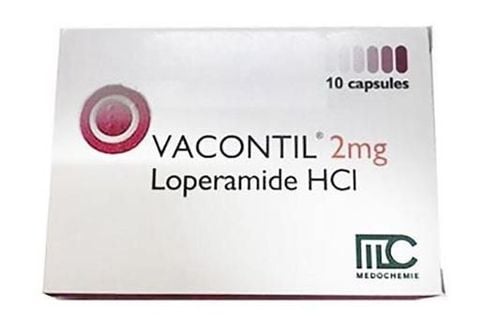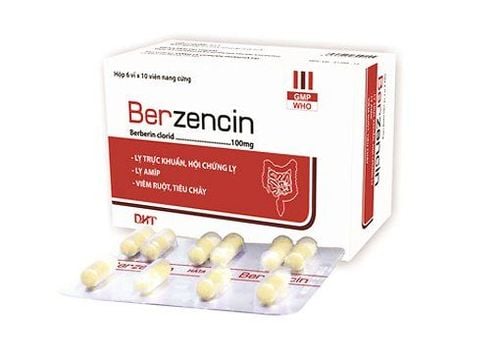This is an automatically translated article.
Agicipro is manufactured by the branch of Agimexpharm pharmaceutical joint stock company, belonging to the group of drugs for the treatment of parasites, anti-infectives, antivirals and antifungals. So what is Agicipro used for? Used how?
1. What is Agicipro?
Agicipro medicine has the main ingredient containing the active ingredient Ciprofloxacin (in the form of Ciprofloxacin HCl) with a strength of 500mg. The drug is prepared in the form of film-coated tablets, packed in boxes of 10 blisters, each blister has 10 tablets.
2. Effects of the drug Agicipro
Active ingredient Ciprofloxacin has strong activity and broad-spectrum bactericidal. Bacterial fertility is rapidly reduced, because ciprofloxacin interferes with chromosomal information necessary for normal bacterial metabolism.
In parallel with other classes of antibiotics that do not belong to the group of gyrase inhibitors, ciprofloxacin is not resistant due to this specific mechanism of action. Therefore, Ciprofloxacin is highly effective against bacteria resistant to other antibiotics such as: Cephalosporins, Aminoglycosides, Tetracycline, Penicillin and other antibiotics. Ciprofloxacin can be combined with the following drugs: Ceftazidime, Azlocillin, Mezlocillin, Beta-lactam antibiotics, especially Vancomycin, Isoxazolylpenicillin, Clindamycin, Metronidazol.
Drug Agicipro is indicated for use in the following cases:
Treatment of ear, nose and throat infections, respiratory infections, acute bacterial episodes of chronic bronchitis, acute sinusitis, Treatment of kidney infections , upper and lower urinary tract uncomplicated. Treatment of genital tract infections (including gonorrhea), obstetric and gynecological infections. Treatment in prostatitis, severe bacterial enteritis, osteomyelitis, soft tissue infections, blood infections, severe hospital-acquired infections, eye infections. Treatment of infections in the gastrointestinal tract, bile ducts. Prophylaxis in infections in immunocompromised individuals and meningococcal disease.
3. How to use and dose Agicipro
How to use Agicipro:
Agicipro is prepared in the form of film-coated tablets, used orally, should be taken after meals about 2 hours, take the drug with plenty of water; Antiacids should not be taken within 2 hours after the patient has taken Agicipro. Dosage of the drug Agicipro:
In skin, bone, soft tissue infections, chronic prostatitis, severe infectious enteritis: Take 1 tablet/time x 2 times a day. In urinary tract infections: Dosage 1⁄2 - 1 tablet / time x 2 times a day, should prolong the use of the drug from 7 to 14 days. In uncomplicated acute cystitis: 1⁄2 tablets/time x 2 times a day, orally for 3 days. In complicated urinary tract infections: Take 1 tablet / time x 2 times a day, take the drug within 7 to 14 days. In uncomplicated gonorrhea: Use a single dose of 500mg/time. In severe nosocomial infections and sepsis: Take 1 tablet x 2 times a day, lasting from 7 to 14 days. In acute sinusitis: Take 1 tablet x 2 times a day, and use it for 10 days. In lower respiratory tract infections: Use 1 - 1.5 tablets / time x 2 times a day, use within 7 to 14 days. For most infections, treatment should continue for at least 48 hours after the patient has been symptom-free. The duration of treatment with Agicipro usually lasts from 1 to 2 weeks, but with severe infections or complications, the treatment day may need to be extended. In the treatment of osteoarticular infections, treatment should be continued for 4 to 6 weeks. For patients with impaired liver or kidney function, the dose should be adjusted. In children and adolescents: Divide dose based on weight, take from 7.5 to 15mg/kg body weight/day, divided from 2 to 3 times a day. Overdose and treatment:
When the patient takes a large amount of medicine, it is necessary to notify the doctor immediately so that supportive treatment can be performed such as gastric lavage, vomiting, diuretic.
4. Undesirable effects of the drug Agicipro
During the use of Agicipro, besides the therapeutic effects, although the active ingredient Ciprofloxacin is well tolerated, however, the patient may still experience unwanted effects as follows:
Common side effects Common: Vomiting, nausea, abdominal pain, diarrhea, transient increase in the concentration of transaminases. Uncommon and rare side effects such as: Drug fever, headache, anaphylactoid reactions, polymorphonuclear leukopenia, eosinophilia, anemia, lymphocytopenia, thrombocytopenia, changes in plasma levels Prothrombin, tachycardia, convulsions, agitation, confusion, paranoia, psychosis, depression, insomnia, visual disturbances including hallucinations, peripheral dysesthesia, tinnitus, hearing disturbance sense of smell, taste, increased intracranial pressure, pseudomembranous colitis, gastrointestinal disturbances, Lyell's syndrome, pruritus, skin-mucosal syndrome, superficial phlebitis, rash, swelling and pain in joints, tendonitis, transient elevation of bilirubin/creatinine/alkaline phosphatase in the blood, hepatitis, hepatocellular necrosis, cholestatic jaundice, hematuria, interstitial nephritis, acute renal failure. Other undesirable effects: Pulmonary edema, bronchospasm, dyspnea, laryngeal edema, photosensitivity to sunlight.
5. Agicipro drug interactions
The effect of Agicipro is increased when used concomitantly with NSAIDs (Indomethacin, Ibuprofen). Serum concentrations and bioavailability of ciprofloxacin are reduced when co-administered with magnesium and aluminum antacids. Therefore, it is necessary to take an anti-acid medication 2-4 hours before using Agicipro. Cytotoxic drugs such as Vincristin, Cyclophosphamide, Cytosin arabinoside, Doxorubicin, Mitozantron reduce the absorption of Agicipro by half when used simultaneously. Agicipro should be taken 2 hours before Didanosin or 6 hours after Didanosin. Because when used concurrently, Didanosin will reduce the concentration of Ciprofloxacin. Preparations containing iron or zinc such as: Gluconate, fumarate, sulfate reduce the absorption of ciprofloxacin in the intestine, so these drugs should be used as far apart as possible. Theophylline serum concentrations may increase and cause adverse effects when administered concomitantly with Agicipro. Theophylline dose reduction may be considered if both drugs are required. There may be a transient increase in serum creatinine when Agicipro is co-administered with ciclosporin. Agicipro increases the effect of oral anticoagulants such as Warfarin. Elimination of Agicipro is reduced when co-administered with Probenecid. Agicipro and Sucralfate should be taken 2 to 6 hours apart, because Sucralfate will reduce the absorption of Ciprofloxacin if taken together.
6. Notes when using Agicipro
Contraindications of Agicipro:
Patients with a history of hypersensitivity to Ciprofloxacin, Quinolone antibiotics, Nalidixic Acid or any of the excipients of the drug. Not for use by pregnant women and nursing mothers. Not for use in young children, children, with a history of tendonitis, tendon rupture and epilepsy. Caution when using Agicipro:
Care should be taken in patients with central nervous system disorders, myasthenia gravis, G6PD deficiency, renal failure, liver failure. Bacteria that are not sensitive to the drug may overgrow with long-term use of Agicipro, which requires regular antibiogram to have an appropriate treatment regimen. Tests for Mycobacterium tuberculosis may be negative during the use of Agicipro . The drug can cause dizziness, insomnia, hallucinations and confusion, therefore caution should be exercised in driving vehicles and operating machinery. Fluoroquinolone antibiotics have been associated with serious adverse reactions that can be disabling and irreversible in various body systems. Commonly reported adverse reactions include tendon rupture, tendinitis, myalgia, arthralgia, hallucinations, depression, anxiety, insomnia, peripheral neuropathy. These reactions may occur simultaneously in the same patient. The drug should be discontinued at the onset of symptoms related to the above serious reactions.
7. Storing Agicipro
Store Agicipro in a cool, dry place, avoid direct sunlight or high temperature, because these agents can change the substances in the drug. The appropriate storage temperature is below 30 degrees Celsius. Before using the medicine, it is necessary to check the expiry date, sensory changes such as color change, moldy or watery, if any, do not use the blister pack. Keep out of reach of children to prevent misuse. Above is information about uses, dosage and precautions when using Agicipro. To ensure safety for your health and maximize the effectiveness of your treatment, you need to take Agicipro exactly as directed by your doctor.













